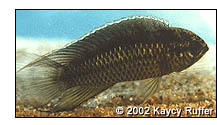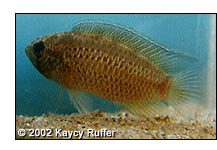 These fish are found in Western Guyana and were first founded by Fritz Mayer, Hamburg, West Germany in 1934.
These fish are found in Western Guyana and were first founded by Fritz Mayer, Hamburg, West Germany in 1934.
In the spring of 1994 I acquired a very young group of Nannacara anomala.
I knew nothing about them. After finding a photo of these fish I
decided to give them a try. The irredescent green coloring on the male
was so beautiful that I couldn't resist them.
I set the pair up in a 20-gallon tank with 1½" of fine sand, a large Anubius 'barteri'
plant (which floated at the surface), and a three inch clay flower pot.
Their hardness was 5.0 - 7.0 pH. and a temperature of 78° F.
I was totally taken aback when the pair had
spawned. In Apistogramma species the female usually turns yellow with a
varied pattern of black according to the  species but in this species of N. anomala
the female is black with some yellowing on her body! She was a sight to
behold. A real difference considering her regular coloring when not in
spawning coloration. She is still a beautiful fish in her own right as
is. The male was approximately 2¼" in length and the female was much
smaller at a size of 1¼". I would find on many occasions the male
hiding in the upper left rear corner of the tank hidden from the
females' view by the large 'barteri' plant after spawning. Most females
of the Dwarf Cichlids are smaller than the males but they can still
hold their own when it comes to protecting their eggs and young.
species but in this species of N. anomala
the female is black with some yellowing on her body! She was a sight to
behold. A real difference considering her regular coloring when not in
spawning coloration. She is still a beautiful fish in her own right as
is. The male was approximately 2¼" in length and the female was much
smaller at a size of 1¼". I would find on many occasions the male
hiding in the upper left rear corner of the tank hidden from the
females' view by the large 'barteri' plant after spawning. Most females
of the Dwarf Cichlids are smaller than the males but they can still
hold their own when it comes to protecting their eggs and young.
The eggs took two to three days to hatch. The
female usually moved the fry to shallow depressions she made in the
sand every day until the fry were free swimming, which took another
five to seven days. After about two weeks the female would allow the
male to help her care for the fry. The one thing I found interesting
about this female is she never spawned on the same location of the pot.
Once in a great while she even spawned inside the pot.
I was very surprised to see the male trying to hide
in the upper corner out of sight (he hopes) of the brooding female.
He would hide behind the floating anubias plant. □



